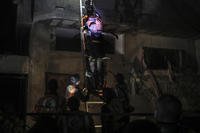Navy acquisition executive Sean Stackley said the Pentagon needs to ensure that it has an offset strategy to preserve funding for innovation as ground wars in Iraq and Afghanistan wind down and the military looks to the future.
Making reference to past budget down turns following World War II and Vietnam, Stackley described offset strategies as necessary to avoid choking off developments under budget pressure and instrumental in ensuring that next-generation platforms don’t suffer by not having the advantage of technological superiority.
“Our defense strategy is built around technical superiority. The offset strategy is an emphasis upon innovation and going after the technologies we need for next-generation weapons systems,” Stackley said Jan. 7 at the Atlantic Council, a Washington D.C.-based think tank.
Stackley said other navies around the globe are making substantial investments in maritime technology and that U.S. superiority cannot be assumed.
Stackley highlighted a handful of impactful technology areas and platforms currently being focused on by the Navy and indicated the importance of emphasizing innovation in the upcoming 2016 defense budget request.
“We need to revisit the technology roadmap. We’re taking a hard look at our way ahead including cyber warfare, electronic warfare, directed energy, stealth, air and missile defense and penetrating strike. We’re looking at air dominance beyond today’s joint strike fighter which may or may not be manned or unmanned,” Stackley said.
It is important that the Navy preserve its undersea dominance as well, Stackley added.
“We see parity forming in other areas but we don’t see parity coming in undersea dominance,” he said.
Stackley cited the Navy’s carrier-launched F-35C and the Ford-class aircraft carriers now under development. He also mentioned the now-in-development Long Range Anti-Ship Missile, or LRASM and the Surface Ship Torpedo Defense System recently tested aboard the USS Bush, an aircraft carrier. The Navy’s Triton unmanned aircraft system and electronic warfare upgrades were also mentioned by Stackley.
The Navy is also developing a beyond-the-horizon-strike and defensive technology called Naval Integrated Fire Control – Counter Air – a system which extends beyond the radar horizon. The system uses radar, an Advanced Hawkeye as an airborne relay sensor and an SM-6 missile to locate and destroy approaching anti-ship cruise missiles at much greater distances than existing systems can.
The Navy’s newly developed P-8 surveillance plane was also cited by Stackley. He referred to it as an example of effectively blending commercial and military technologies in order to ensure the platform keeps pace with technological development.








